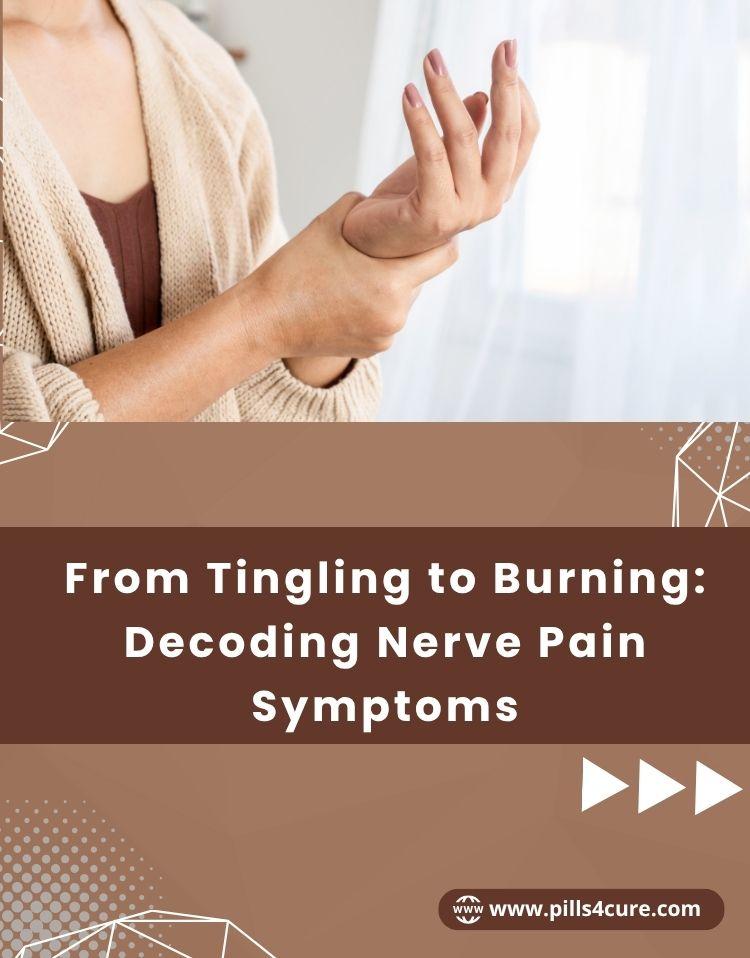Early Signs of Peripheral Nerve Pain You Shouldn't Ignore

Peripheral nerve pain, a debilitating condition affecting millions globally, often goes unnoticed in its early stages, delaying critical intervention. The peripheral nervous system, which links your brain and spinal cord to the rest of your body, is essential for transmitting sensory signals and coordinating muscle movement. When these nerves become damaged or diseased, the resulting pain can profoundly disrupt your quality of life. Unlike central nervous system disorders, peripheral nerve conditions typically develop slowly, making early detection difficult. Recognizing the warning signs, understanding the nature of peripheral nerve pain, and knowing when to seek professional help are vital for effective management and preventing chronic suffering. Treatments like pregabalin medicine can offer significant relief for nerve pain when used under medical guidance. This comprehensive guide explores the symptoms, causes, and advanced treatments for nerve pain, empowering you to take charge of your neurological health with confidence.
What is Peripheral Nerve Pain?
Peripheral nerve pain, also known as peripheral neuropathy, occurs when nerves outside the brain and spinal cord become damaged or dysfunctional. These peripheral nerves are responsible for transmitting information between your central nervous system and the rest of your body, including your arms, legs, hands, and feet.
The condition can manifest in various forms, ranging from mild tingling sensations to extreme nerve pain that interferes with daily activities. The severity and type of symptoms depend on which nerves are affected and the underlying cause of the damage.
There are three main types of peripheral nerves:
- Sensory nerves: Control sensation and feeling
- Motor nerves: Control muscle movement
- Autonomic nerves: Control involuntary functions like heart rate and digestion
When any of these nerve types become damaged, it can result in a complex array of symptoms that require specialized nerve pain management approaches.
Common Symptoms and Early Warning Signs
Recognizing the early signs of peripheral nerve pain is crucial for timely intervention and effective nerve pain treatment. The symptoms can vary significantly depending on the type and location of nerve damage, but several common warning signs should not be ignored:
Sensory Symptoms
- Tingling or "pins and needles" sensations, particularly in hands and feet
- Numbness or reduced ability to feel pain or temperature changes
- Sharp, jabbing, or burning pain that may worsen at night
- Extreme sensitivity to touch, even from light clothing or bedsheets
- Loss of coordination and balance
Motor Symptoms
- Muscle weakness, particularly in the hands and feet
- Difficulty with fine motor skills like buttoning clothes or writing
- Muscle cramps or twitching
- Progressive muscle wasting in advanced cases
Autonomic Symptoms
- Digestive issues, including nausea and constipation
- Changes in blood pressure and heart rate
- Excessive sweating or inability to sweat
- Problems with bladder control
The progression from mild symptoms to extreme nerve pain can occur gradually over months or years, making it essential to seek medical attention at the first sign of persistent neurological symptoms.
Causes and Risk Factors
Understanding the underlying causes of peripheral nerves conditions is essential for developing an effective treatment strategy. The causes can be broadly categorized into several groups:
Metabolic Disorders
Diabetes is the leading cause of peripheral neuropathy, accounting for approximately 60% of cases. High blood sugar levels can damage nerve fibers over time, leading to diabetic neuropathy. Other metabolic conditions include thyroid disorders and kidney disease.
Autoimmune Conditions
Various autoimmune diseases can trigger the immune system to attack peripheral nerves, including rheumatoid arthritis, lupus, and Guillain-Barré syndrome.
Infections
Certain viral and bacterial infections can damage peripheral nerves, including shingles, Epstein-Barr virus, hepatitis B and C, and Lyme disease.
Toxic Exposure
Exposure to heavy metals, certain medications (particularly chemotherapy drugs), and excessive alcohol consumption can lead to toxic neuropathy.
Genetic Factors
Inherited disorders such as Charcot-Marie-Tooth disease can cause progressive peripheral nerve damage.
Physical Trauma
Injuries from accidents, repetitive stress, or compression can damage peripheral nerves and lead to chronic pain conditions.
Diagnosis and Medical Evaluation
Proper diagnosis of nerve pain disease requires a comprehensive medical evaluation. Healthcare providers typically use a combination of approaches to identify the underlying cause and extent of peripheral nerve damage:
Clinical Assessment
A thorough medical history and physical examination form the foundation of diagnosis. Your doctor will assess your symptoms, review your medical history, and perform neurological tests to evaluate nerve function.
Diagnostic Tests
- Nerve conduction studies: Measure the speed and strength of electrical signals through nerves
- Electromyography (EMG): Evaluates electrical activity in muscles
- Blood tests: Screen for diabetes, vitamin deficiencies, and autoimmune conditions
- Imaging studies: MRI or CT scans may be used to identify structural abnormalities
- Nerve biopsy: In rare cases, a small sample of nerve tissue may be examined
Early and accurate diagnosis is crucial for implementing effective treatments for nerve pain and preventing further nerve damage.
Treatment Options and Management Strategies
Effective nerve pain management requires a multifaceted approach that addresses both the underlying cause and the symptoms. Treatment options can be broadly divided into several categories:
Medications for Nerve Pain Treatment
Anticonvulsants: Pregabalin medicine has become a cornerstone of peripheral nerve pain treatment. Originally developed for epilepsy, pregabalin works by reducing abnormal electrical activity in damaged nerves. Studies have shown that pregabalin medicine can significantly reduce pain intensity and improve quality of life for patients with peripheral neuropathy.
Antidepressants: Tricyclic antidepressants and selective serotonin-norepinephrine reuptake inhibitors (SNRIs) can help manage nerve pain by affecting neurotransmitter levels in the brain and spinal cord.
Topical treatments: Capsaicin cream and lidocaine patches can provide localized relief for some patients.
Opioids: Reserved for severe cases due to the risk of dependence and tolerance.
Non-Pharmacological Treatments
- Physical therapy: Helps maintain muscle strength and improve coordination
- Occupational therapy: Teaches adaptive techniques for daily activities
- Transcutaneous electrical nerve stimulation (TENS): Uses mild electrical impulses to reduce pain
- Acupuncture: May provide relief for some patients with chronic nerve pain
Advanced Interventions
For patients with extreme nerve pain that doesn't respond to conventional treatments, advanced interventions may be considered:
- Spinal cord stimulation: Implanted devices that deliver electrical pulses to interrupt pain signals
- Nerve blocks: Injections that temporarily block pain signals
- Plasma exchange: For autoimmune-related neuropathies
Lifestyle Modifications and Self-Care
Managing peripheral nerves conditions extends beyond medical treatment. Lifestyle modifications play a crucial role in symptom management and overall well-being:
Diet and Nutrition
- Maintain stable blood sugar levels, especially important for diabetic patients
- Ensure adequate intake of B vitamins, particularly B12, B6, and thiamine
- Limit alcohol consumption, which can worsen nerve damage
- Follow an anti-inflammatory diet rich in omega-3 fatty acids
Exercise and Physical Activity
Regular, low-impact exercise can help improve circulation, maintain muscle strength, and potentially slow the progression of nerve damage. Recommended activities include:
- Walking and swimming
- Gentle stretching and yoga
- Balance training to prevent falls
- Strength training with light weights
Stress Management
Chronic pain can increase stress levels, which may worsen symptoms. Effective stress management techniques include:
- Meditation and mindfulness practices
- Deep breathing exercises
- Progressive muscle relaxation
- Adequate sleep hygiene
Precautions and Safety Measures
Living with peripheral nerve pain requires special attention to safety and injury prevention:
Foot Care
Patients with peripheral neuropathy, particularly those with diabetes, must pay special attention to foot care:
- Inspect feet daily for cuts, blisters, or changes in color
- Wear properly fitting shoes and avoid walking barefoot
- Keep feet clean and dry
- Trim toenails carefully to prevent ingrown nails
Home Safety
- Remove tripping hazards like loose rugs and clutter
- Install adequate lighting, especially in hallways and bathrooms
- Use handrails on stairs and grab bars in bathrooms
- Consider wearing shoes with good grip to prevent falls
Temperature Sensitivity
Many patients with nerve pain disease have reduced ability to sense temperature changes:
- Test water temperature with an unaffected area before bathing
- Use mittens or gloves when handling hot or cold objects
- Be cautious with heating pads and ice packs
Medication Safety
When using pregabalin medicine or other nerve pain treatments:
- Take medications exactly as prescribed
- Don't stop medications abruptly without consulting your doctor
- Be aware of potential side effects and drug interactions
- Keep a medication log to track effectiveness and side effects
Frequently Asked Questions (FAQs)
Q: How long does it take for nerve pain treatment to show results?
A: The timeline for improvement varies depending on the underlying cause and treatment approach. Some patients may experience relief within days of starting pregabalin medicine, while others may need several weeks or months to see significant improvement. It's important to work closely with your healthcare provider to find the most effective treatment combination.
Q: Can peripheral nerve pain be cured completely?
A: The potential for complete recovery depends on the underlying cause. Some forms of peripheral neuropathy, particularly those caused by vitamin deficiencies or certain infections, may improve significantly with appropriate treatment. However, many chronic conditions require ongoing nerve pain management rather than offering a complete cure.
Q: Is extreme nerve pain always a sign of serious disease?
A: While severe nerve pain can indicate significant nerve damage, it doesn't always correlate with the extent of the underlying condition. Some patients with mild nerve damage experience intense pain, while others with more extensive damage have relatively mild symptoms. Professional medical evaluation is essential for proper diagnosis and treatment planning.
Q: Are there any natural remedies effective for peripheral nerve pain?
A: Several natural approaches may complement medical treatments for nerve pain, including alpha-lipoic acid supplements, evening primrose oil, and certain herbal remedies. However, these should never replace prescribed medications without medical supervision, and their effectiveness varies among individuals.
Q: How does pregabalin medicine work for nerve pain?
A: Pregabalin works by binding to calcium channels in nerve cells, reducing the release of neurotransmitters that transmit pain signals. This mechanism helps calm overactive nerves and reduce the intensity of neuropathic pain. The medication typically needs to be taken regularly for optimal effectiveness.
Q: Can stress make peripheral nerve pain worse?
A: Yes, stress can exacerbate nerve pain through several mechanisms. Stress hormones can increase inflammation and heighten pain sensitivity. Additionally, stress often leads to muscle tension and poor sleep, both of which can worsen pain perception. Effective stress management is an important component of comprehensive nerve pain management.
Q: When should I seek emergency medical care for nerve pain?
A: Seek immediate medical attention if you experience sudden onset of severe weakness, difficulty breathing, rapid progression of symptoms, or signs of infection such as fever along with nerve pain. These could indicate serious complications requiring urgent treatment.
Q: Can peripheral nerve damage regenerate?
A: Unlike nerves in the central nervous system, peripheral nerves have some capacity for regeneration, particularly if the underlying cause is addressed early. However, the extent of recovery varies greatly depending on factors such as the cause of damage, duration of symptoms, and individual patient characteristics.








